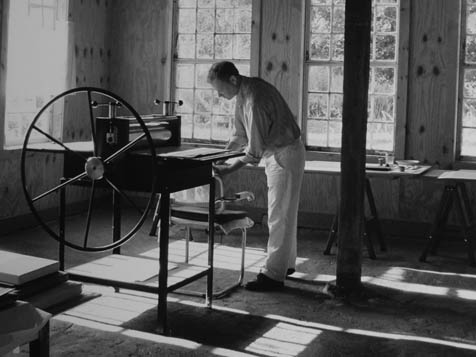Voyage Imaginaire -From China to Paris: Recent Artist Books of Gunnar A. Kaldewey.
At Davidson Library Special Collections, UCSB. Shows through March 28.

Book artist Gunnar A. Kaldewey sees global culture as an existing reality and hopes his books help foster a sense of global community. The nine books in his current exhibit symbolically track the route of the Silk Road, but in reverse of the Eurocentric orientation from which it is traditionally regarded. Chosen over a span of 15 years, the texts of the books, as well as their designs and the materials from which they are made, are representative of the cultures of China, Tibet, Persia, Italy, and France. These are works that reflect a highly sophisticated integration between object and content. They render the experience of reading inseparable from the sensual aspects of sight and touch.
Kaldewey has a long and distinguished career as a book artist. He made his first book in 1976, under the tutelage of letterpress printers in Germany. In 1985 he formed Kaldewey Press in Poestenkill, New York. His books have been exhibited in more than 100 museums and libraries worldwide. The sincerity of Kaldewey’s passion for world culture is reflected not only in the extent to which he and his work have traveled, but also in the influence of those travels-an influence that is visually evident in the books themselves. Emblematic of the exhibit’s Silk Road theme are three books devoted to poems about wine: one by the 8th-century Chinese poet Li Po, one by the 14th-century Persian poet Hafez, and one by the 19th-century French poet Charles Baudelaire. Each is printed in the language native to its respective culture, with appended translations. “Nai Nameh (Song of the Reed),” a poem by the 13th-century Persian poet Jalal al-Din Rumi, is printed blind (without ink), in raised Arabic characters on tissue-thin oxide yellow paper. In Saikontan, a collection of 10 passages from The Roots of Wisdom by Ming Dynasty philosopher Hung Ying-Ming are printed on paper Kaldewey made from unbleached abaca.
All of the Chinese characters in Kaldewey’s books are printed from calligraphy made by his life partner, composer Bun-Ching Lam. Kaldewey and Lam frequently influence and inspire each other and often collaborate. As a complement to the exhibit, readings in eight languages will be performed on January 22, supported by passages from Lam’s Atlas, a composition for instruments indigenous to the cultures of the Silk Road, commissioned by the Holland Festival.
Voyage Imaginaire is an exhibit that demonstrates the powerful influence presentation can have upon meaning. It is a gentle invitation to expand one’s perspective and explore world culture with respect and with reverence.
4•1•1
A reading and performance featuring Bun-Ching Lam, Thomas Buckner, and Gunnar Kaldewey will take place on Tuesday, January 22, at 5 p.m. at the Old Little Theater, College of Creative Studies, UCSB. Call 893-8974 or visit ccs.ucsb.edu.



